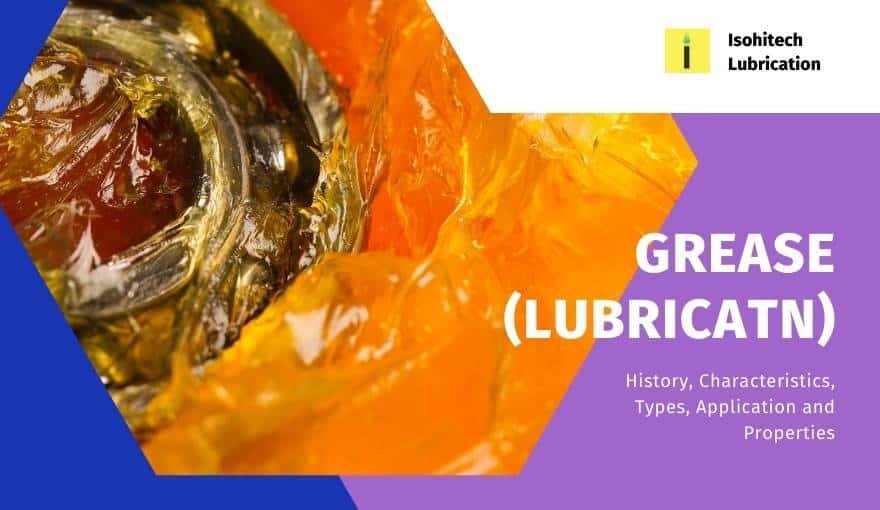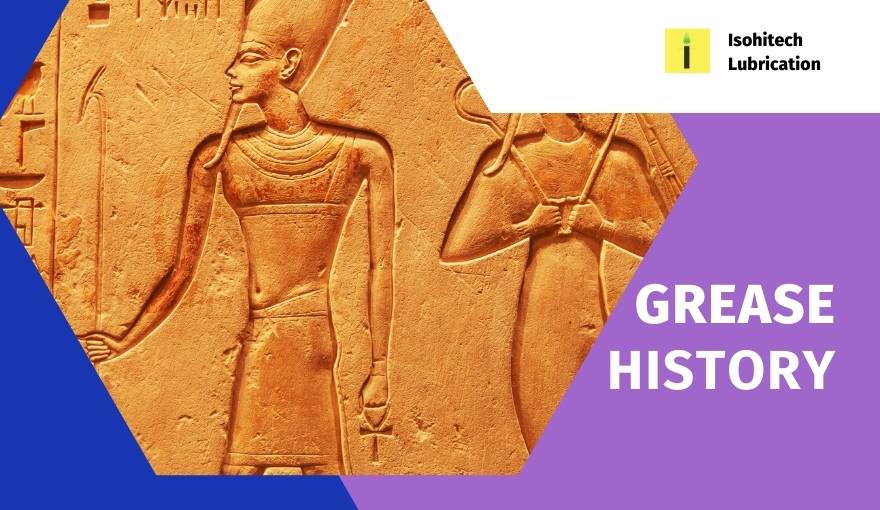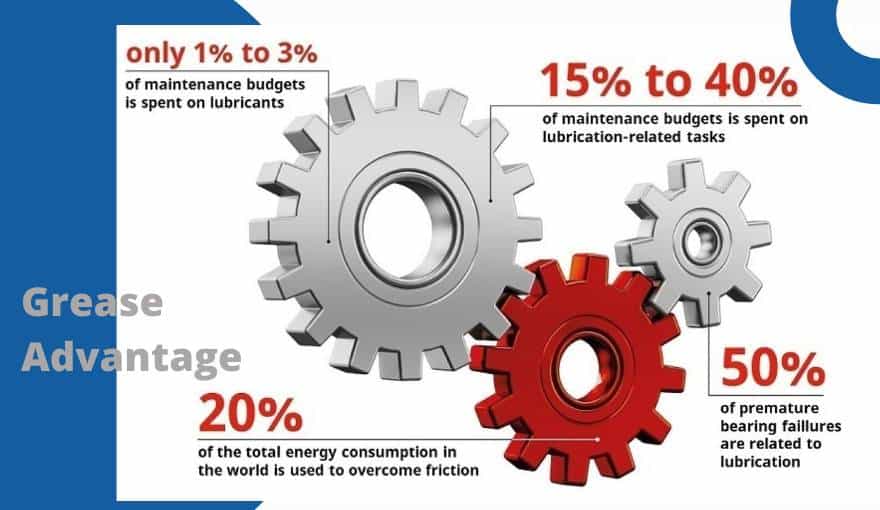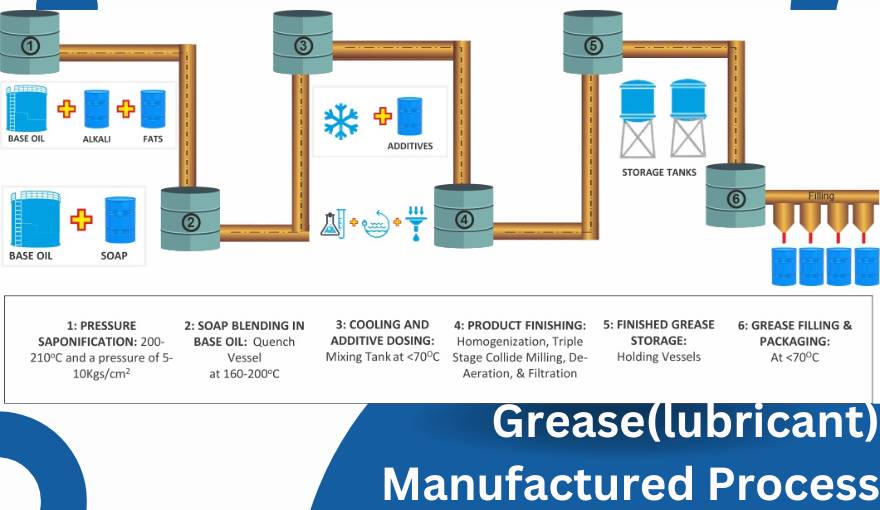As we explore greases, we can’t help but ask: How does grease ensure the operation of modern machinery? From the chariots of ancient Egypt to the bearings of modern high-precision machinery, the evolution of grease has significantly propelled technological advancement.
In this article, we will delve into the history, types, manufacturing processes, and key roles of grease in various industries, revealing how this seemingly simple substance has become an indispensable part of industrial and technological development.
目次
 What are Grease (Lubricant)?
What are Grease (Lubricant)?
Grease is a typical semi-solid or solid lubricant, formed by dispersing a thickening agent in a liquid lubricant. The main components of grease include base oil, thickener, and additives. Base oils may be petroleum derivatives or synthetic products, which primarily serve the lubricating function. Thickeners are usually a type of soap made from a reaction between metal elements and fatty acids, serving to fix the oil and provide the grease with a characteristic thickness. Additives enhance the performance of grease, such as antioxidation, corrosion control, and load-bearing capacities.
What is the History of Grease (Lubricant)?

The history of grease as a lubricant is long and fascinating, dating back to ancient civilizations and has evolved significantly over the centuries. The earliest greases trace back to ancient Egypt and Rome, where animal fats were used to lubricate chariot axles to reduce friction and wear on mechanical parts. The discovery of petroleum in the mid-19th century greatly altered lubrication technology, offering a more effective and reliable source of lubricant compared to animal and vegetable oils. Synthetic lubricants’ development marked a significant milestone in lubrication history. In 1877, French chemist Charles Friedel and American James Mason Crafts synthesized the first hydrocarbons, laying the foundation for synthetic lubricants. This innovation was driven by the increasing demands of modern machinery and automobile engines to operate under extreme conditions such as high temperatures and pressures. During the 1920s and 1930s, the introduction of additives began to enhance the performance of lubricants. These additives aimed to inhibit oxidation, resist corrosion, and improve the viscosity of lubricants, thereby extending their lifespan and reliability.
Modern Progress
Today, the development of lubricants continues with a focus on efficiency, reducing environmental impact, and meeting the stringent requirements of advanced mechanical equipment. The formulation of modern greases is complex, including various thickeners such as lithium soap and calcium sulfonate, as well as performance-enhancing additives like molybdenum disulfide and graphite.
How is Grease (Lubricant) Made?
Grease is produced by dispersing a thickener into the lubricating oil to form a stable semi-solid product. This process typically involves heating the base oil at a specific temperature and adding metal soap thickeners. The mixture is then sheared to ensure thorough mixing of the thickener with the lubricating oil. To enhance the grease’s performance in specific applications, specialty additives such as extreme pressure agents, antioxidants, and rust inhibitors are also added. Solid lubricants may be included to improve lubricity and wear resistance. Finally, the grease is filtered to remove any unwanted particles, then cooled and packaged for distribution.
What are the Different Types of Grease (Lubricant)?

Different types of grease vary in their base oils, thickeners, and additives, with formulations tailored to meet specific requirements and applications. Some common types of grease and their typical uses include:
- Calcium-based grease: This is a general-purpose grease suitable for various applications. It has good water resistance and anti-corrosion properties but is not suitable for high-temperature applications. It is commonly used in industrial, marine, and agricultural environments.
- リチウムベースのグリース: Known for its high viscosity and durability, lithium-based grease is ideal for metal-to-metal applications. It prevents corrosion, extreme weather conditions, and wear. It can withstand high pressure and shock loads, making it suitable for automotive and industrial uses.
- Complex aluminum grease: This type of grease can withstand very high temperatures and has excellent water resistance. It also prevents rust and oxidation and has good shear stability. It is suitable for the food and beverage industry as well as construction and breeding industries.
- Complex barium grease: A high-performance grease with very high mechanical stability and resistance to high temperatures. It also resists various chemicals and has strong load-bearing capabilities, making it suitable for aviation, maritime, and manufacturing industries.
- Bentone (clay) grease: Made with Bentone clay, this grease performs well at different temperatures and is known as a non-melting grease. It has water resistance properties and serves as a good adhesive, commonly used in the steel, mining, and ceramic industries.
- Polyurea grease: This grease has multiple characteristics, including excellent water resistance, anti-rust and antioxidation properties, and high-temperature performance, making it popular. It plays a critical role in steel mills and motors.
- Sodium-based grease: Made by mixing base oil with additives and sodium soap, it has good rust protection but poor water resistance and antioxidation properties. It is often mixed with other greases to improve quality.
- Synthetic-based grease: These greases have better tolerance for extreme temperatures and environments than mineral-based greases. They also have betterantioxidation properties, which can extend the life of the lubricant.
- Mineral-based grease: This type of grease has high mechanical stability and excellent corrosion resistance properties. It is cost-effective and suitable for the automotive industry, motors, and pumps.
- 多目的グリース: Commonly used in the automotive industry, this grease is typically made from calcium sulfonate and has very high water resistance. However, it is not designed for high-heat applications.
- マリングリース: Designed to withstand higher water contact strength, suitable for boats and boat trailers. It is important to note that it is incompatible with lithium-based products.
What are the Advantages of Grease (Lubricant)?
 Grease offers several advantages as a lubricant, making it suitable for specific applications where oils may not be as effective. Some of the main benefits of using grease include:
Grease offers several advantages as a lubricant, making it suitable for specific applications where oils may not be as effective. Some of the main benefits of using grease include:
- リークコントロール: Compared to lubricating oils, the higher viscosity of grease helps it adhere better to surfaces. This property significantly reduces the risk of leaks, especially in systems where seals wear out or joints become loose.
- Contamination prevention: Grease acts as a sealant for bearings and other machine parts, helping to prevent water, dust, and other contaminants from entering. This sealing capability is crucial for machines operating in dirty or wet environments.
- 耐用性アップ: Grease stays in place longer in equipment than oil, reducing the need for frequent reapplication. This can lower maintenance costs and reduce downtime.
- 構造安定性: Unlike oil, grease can maintain its thickness and does not require a circulation system for effective distribution. Therefore, it is particularly suitable for machines that are difficult to access or operate intermittently.
- Load-bearing and shock protection: Compared to oil, grease can better withstand heavy loads and prevent shock loads, making it suitable for high-pressure and high-load applications.
- 温度耐性: Some types of grease can perform well under extreme high and low temperature conditions, which is advantageous in harsh operating conditions.
- 消費量の削減: Since grease does not run off from the point of use like machine oil, it has a longer lifespan, reducing the long-term use of lubricant.
- シンプルなメンテナンス: Grease does not require the complex and often costly maintenance systems needed for oil lubrication (such as pumps, filters, and sumps), simplifying the lubrication process.
What are the Disadvantages of Grease (Lubricant)?
The disadvantages of using grease as a lubricant include several factors that may affect its performance and suitability for certain applications:
- 温度制限: Grease can degrade or lose effectiveness at high temperatures. This degradation can lead to the separation of the base oil from the thickener, reducing the lubricating effect of the grease.
- 汚染に対する敏感さ: Grease is easily contaminated by dust, dirt, and other particles, especially in open or poorly sealed systems. This contamination can reduce the effectiveness of grease, leading to increased mechanical wear.
- メンテナンスの複雑さ: Although grease does not need to be reapplied frequently, it does need to be replaced periodically. The process of cleaning old grease and applying new grease is time-consuming and labor-intensive, especially in large or complex machinery.
- エネルギー消費: Compared to oil, grease has a greater initial movement resistance, which can lead to increased energy consumption during the startup phase of machinery. This is because the higher thickness of grease requires more energy to move through and lubricate mechanical parts.
- 非互換性の問題: Different types of grease may be incompatible with each other. Mixing different greases can lead to the breakdown of thickeners and loss of lubrication performance, potentially damaging machinery.
- Limited cooling capability: Unlike oil, grease does not circulate within the system and therefore does not provide the same cooling effect. This can be a disadvantage in applications with high heat dissipation requirements.
- Difficulty in monitoring wear: Monitoring the condition of grease is more challenging than with oil. Oil can be easily sampled and analyzed for contaminants and wear particles, while grease requires more effort to extract and analyze, making routine maintenance checks more cumbersome.
What are the Common Grades of Grease (Lubricant)?
 The National Lubricating Grease Institute (NLGI) classifies common grease grades based on their consistency. NLGI grades range from 000 to 6, with each grade corresponding to a specific working penetration value measured in tenths of a millimeter. Here are the common NLGI grades and their typical consistencies:
The National Lubricating Grease Institute (NLGI) classifies common grease grades based on their consistency. NLGI grades range from 000 to 6, with each grade corresponding to a specific working penetration value measured in tenths of a millimeter. Here are the common NLGI grades and their typical consistencies:
- NLGI grade 000: Fluid-like consistency, similar to cooking oil.
- NLGI grade 00: Semi-fluid consistency, similar to apple sauce.
- NLGI grade 0: Very soft, similar to brown mustard.
- NLGI grade 1: Soft, similar to tomato ketchup.
- NLGI grade 2: Normal grease consistency, similar to peanut butter. This is the most commonly usedgrade in various applications.
- NLGI grade 3: Harder, similar to vegetable shortening.
- NLGI grade 4: Very hard, similar to frozen yogurt.
- NLGI grade 5: Hard, similar to smooth chutney.
- NLGI grade 6: Very hard, similar to cheddar cheese.
What is the difference between #1 and #2 grease?
The difference between NLGI #1 and #2 grease lies in their thickness and the amount of thickener used in their formulation. NLGI #1 grease has less thickener, making it softer and more fluid, typically performing better in low-temperature conditions. It is easier to pump, especially over longer distances or in colder environments. On the other hand, NLGI #2 grease contains more thickener, making it harder and suitable for a variety of uses. It is the most commonly used grease grade by manufacturers because it maintains stability across a broader and more typical temperature range. Its consistency is similar to peanut butter, making it an ideal lubricant for sliding bearings and anti-friction bearings operating under medium loads and speeds.
Which Grade of Grease (Lubricant) is Best?
The best grade of grease depends on the specific application and operating conditions. However, the most commonly used and versatile grade is NLGI 2. This grade has a balanced consistency, neither too hard nor too soft, suitable for general lubrication needs in various mechanical and automotive applications. It is frequently recommended for a wide range of applications.
What is the Price of Grease (Lubricant)?
Commercially, grease lubricant costs approximately $2-$3 per kg.
What are the Characteristics of Grease (Lubricant)?
Grease as a lubricant possesses various characteristics that play a crucial role in its functionality and suitability for various applications. Here are some of the main characteristics of grease:
- 一貫性: The consistency or hardness of grease is measured by its resistance to deformation under external force. The National Lubricating Grease Institute (NLGI) has a grading system that classifies grease based on its consistency at room temperature, ranging from 000 (very fluid) to 6 (solid block).
- 浸透性: This refers to the depth a standard cone penetrates into the grease under specific conditions. It is a measure of the physical thickness of grease, used to determine its NLGI grade. Grease’s penetrability is also affected by mechanical action during use.
- ドロップポイント: The drop point is the temperature at which grease transitions from a semi-solid to a liquid state. It is an indicator of grease’s heat resistance and helps determine its upper limit of use temperature, although the actual operating temperature should generally be at least 50°C below the drop point.
- ポンパビリティ: This is the ability of grease to be pumped or moved within a system, especially important in centralized lubrication systems. Pumpability is influenced by the viscosity of the grease and the operating temperature.
- 耐水性: Grease’s ability to resist water washout is crucial for applications exposed to moist environments. This characteristic determines the stability of grease when in contact with water.
- 耐食性: This characteristic indicates grease’s ability to protect metal surfaces from corrosion, especially in the presence of water or corrosive substances.
- 耐摩耗性: Grease should provide a protective film to prevent metal-to-metal contact, reducing wear. Tests such as the four-ball wear test can assess the anti-wear properties of grease.
- Bleeding rate: This refers to the tendency of the base oil to separate from the thickener over time. A lower bleeding rate indicates better stability and a longer lifespan for the grease.
- 低温性能: Grease’s low-temperature performance is crucial for applications in cold environments. It includes grease’s ability to maintain lubricity and pumpability at low temperatures.
- 酸化安定性: This characteristic determines grease’s tolerance to react with oxygen, which can cause grease to harden and lose its lubricating properties over time.
- 添加剤: Grease often contains additives such as corrosion inhibitors, extreme pressure additives, antioxidants, and anti-wear additives to enhance performance and provide specific properties required for applications.
What is the Color of Grease (Lubricant)?

The color of grease varies widely and is primarily used for identification purposes by manufacturers. Grease comes in a variety of colors, including black, white, gray, blue, red, purple, green, and yellow. Each color does not necessarily indicate a specific type of grease or its performance characteristics but is often used to differentiate products within the same brand or to make the product more visually appealing. For example:
- White grease typically indicates that the product is food-grade grease, suitable for environments where incidental contact with food may occur.
- Gray or black grease often contains additives such as molybdenum disulfideor graphite, suitable for harsh working conditions.
- Red grease may be used for high-temperature applications, but this is not always the case and should not be the sole factor in selecting the type of grease.
Materials Used in Grease (Lubricant)
The materials used in the formulation of grease include three main components: base oil, thickener, and additives. Each component plays a critical role in the characteristics and performance of grease.
- ベースオイル: This is the primary lubricating component of grease. Base oil can be either mineral oil or synthetic oil. Mineral oil is refined from petroleum and is widely used due to its satisfactory performance under various conditions. On the other hand, synthetic oil is chemically engineered to provide superior performance under extreme conditions such as very high or very low temperatures. Synthetic base oils include polyalphaolefins (PAO) and esters, which have a wider temperature range and better stability.
- 増粘剤: The thickener acts like a sponge, holding the base oil in a semi-solid state. Thickeners can be metal soaps, non-soap thickeners, or complexes. Common soap-based thickeners include lithium soap, calcium soap, aluminum soap, and sodium soap. Non-soap thickeners might include materials like bentonite or polyurea. Complex thickeners are typically made by combining metal soaps with complexing agents to enhance the performance of grease, especially in terms of high drop points and load-bearing capabilities.
- 添加剤: Additives are chemicals added to grease to enhance certain properties or impart new ones. Common additives include antioxidants and rust inhibitors, extreme pressure agents, anti-wear agents, and friction reducers. Some greases also contain solid lubricants such as molybdenum disulfide (moly) or graphite, which are suspended in the grease to reduce friction and wear.
Grease (Lubricant) Manufacturing Processes

The manufacturing processes for grease are varied, each with its own equipment and techniques. Here are the main methods of producing grease:
- けん化: Fatty acids react with alkali to produce the thickener, typically soap.
- 脱水: Removing water produced during the saponification process.
- Milling or homogenization: Breaking down clumped particles to adjust the thickness of the grease, producing a smooth, stable product.
- Cooling and degassing: Cooling the grease to the desired temperature and removing entrained air.
- 追加: Adding performance-enhancing additives such as oxidation inhibitors, corrosion inhibitors, and anti-wear agents.
What are the Applications of Grease (Lubricant)?
Grease’s unique properties, such as high viscosity, the ability to seal out contaminants, and suitability for extreme conditions, make it widely applicable. Here are some of the main applications of grease:
- 自動車産業: Grease is extensively used in the automotive industry for lubricating chassis components, wheel bearings, suspension systems, and steering mechanisms. It provides lasting lubrication and protection under different temperature and load conditions, preventing wear and corrosion.
- 産業機械: In industrial settings, grease is crucial for the smooth operation of conveyors, pumps, and motors. It is used in applications where the lubricant needs to stay in place and provide protection under heavy loads and high pressures.
- 海事用途: Grease is used in marine equipment, offering waterproofing properties and protecting metal parts from saltwater corrosion. It is suitable for lubricating marine deck machinery, steering gears, and other maritime equipment.
- 食品業界: In food processing and packaging machinery, greases that meet specific food-grade standards are used to ensure safety and comply with hygiene regulations. These greases have anti-washout, antioxidation, and anti-contamination properties.
- 農業: Grease is used in agricultural machinery to withstand harsh outdoor conditions, including exposure to dust, soil, and varying weather conditions. It helps maintain the functionality and lifespan of agricultural equipment.
- 建設と採掘: Heavy-duty greases are used in construction and mining equipment to cope with extreme pressures, shock loads, and wear conditions. They provide effective lubrication and protection for machinery operating in these demanding environments.
- 航空宇宙: High-performance greases are used in aerospace applications for bearings, gears, and slides. These greases must withstand extreme temperatures and pressures while providing reliable lubrication.
- Motors and gearboxes: Grease is used in some motor and gearbox applications that are sealed for life, providing long-term lubrication without frequent replenishment.
- Steel mills and paper mills: In heavy industries like steel and paper, grease lubricates machinery operating at high temperatures and heavy loads, ensuring smooth operation and reducing maintenance needs.
What is the difference between grease and oil?
The main difference between grease and lubricating oil lies in their components and physical state, which in turn affects their applications and functionality as lubricants.
- コンポーネント: Grease is essentially oil with added thickeners. Thickeners act like a sponge, holding the base oil and additives together, giving grease a semi-solid or solid structure. In contrast, oil has a syrup-like consistency and does not contain thickeners.
- 物理的状態: At room temperature, grease is usually solid or semi-fluid, while oil is typically liquid. This difference in consistency affects how each type of lubricant is used and where.
- アプリケーション: Grease is primarily used in machinery, tools, and equipment, where it is designed to stay in place and provide a more lasting barrier between metal parts. It is also used as a sealant to prevent contaminants from entering and for applications that involve heavy loads or vertical movement. On the other hand, oil has a wider range of non-industrial uses, better cooling properties, and is easier to penetrate into narrow spaces.
- Functionality : In situations where leakage and dripping occur, where oil circulation is not feasible or difficult to reach, and in highly contaminated environments, grease is preferred. Oil is more suitable for high-temperature applications, high-speed environments, and applications with high heat generation because it can flow and transfer heat away from the application.
- メンテナンス: Grease stays in equipment longer and can withstand various conditions, making it easier to use in most industrial settings. However, oil is easier to drain, control the amount used, and cleaner. It also has better cooling properties, which can extend the life of bearings.
What is the difference between grease and lubricant?
The main difference between grease and lubricating oil lies in their physical state and components. Grease is a semi-solid lubricant formed by dispersing a thickener in a liquid lubricant, typically a mixture of base oil, thickener, and various additives. Grease functions to stay in place under harsh conditions and provide long-term lubrication, making it suitable for applications where liquid lubricants may not meet the requirements.
On the other hand, a lubricant generally refers to a substance that helps reduce friction between contacting surfaces, thereby minimizing the heat generated during surface movement. Lubricants can be liquid, such as oil, or semi-solid, like grease. The term “lubricant” encompasses a broader range, including both oil and grease.
What part do you grease regularly?
Regular greasing is essential for maintaining the performance and lifespan of various mechanical systems and components. Here are some common items and parts that typically require regular greasing:
- 自動車部品:
- ホイールベアリング: These components need regular greasing to reduce friction and prevent premature wear.
- シャーシコンポーネント: Suspension joints, tie rods, and ball joints usually need greasing to ensure smooth operation and prevent squeaking.
- Universal joints and CV joints: These components need regular greasing to maintain flexibility and durability.
- 産業機械:
- ベアリング: Many types of industrial bearings need regular greasing to keep them running efficiently and prevent failures due to overheating or contamination.
- ギア: Open gears especially need frequent greasing to prevent wear and corrosion.
- Pumps and motors: These components typically have specific lubrication intervals to ensure optimal performance and lifespan.
- 農機具:
- トラクターと収穫機: Joints, bearings, and other moving parts in agricultural machinery need regular greasing to withstand the harsh conditions of agricultural operations.
- Conveyors and feeders: These systems need greasing to keep them running smoothly and prevent clogging or mechanical wear.
- Household tools and equipment:
- Lawn mowers and gardening tools: Wheel bearings and cutting devices often need greasing.
- Garage door tracks and rollers: Regular application of grease helps ensure smooth operation and reduce noise.
- Hinges and slides: Door hinges, drawer slides, and similar components occasionally need greasing to prevent squeaking and sticking.
- 娯楽機器:
- 自転車: Hub, pedal bearings, and chain gears should be regularly greased to ensure smooth riding and prevent rust.
- ボート: Marine equipment, especially those exposed to saltwater, needs regular greasing to prevent corrosion and ensure proper function.
まとめ
The wide range of applications and benefits of grease highlights its importance in both industrial and everyday settings. Understanding the different types of grease and their specific properties can help users choose the right product for their needs, ensuring the longevity and efficiency of their machinery and equipment. Whether for automotive, industrial, or recreational use, grease plays a crucial role in reducing wear, preventing contamination, and enhancing the performance of various mechanical components.
If you want to know the more about grease,you could Rescale Support.


